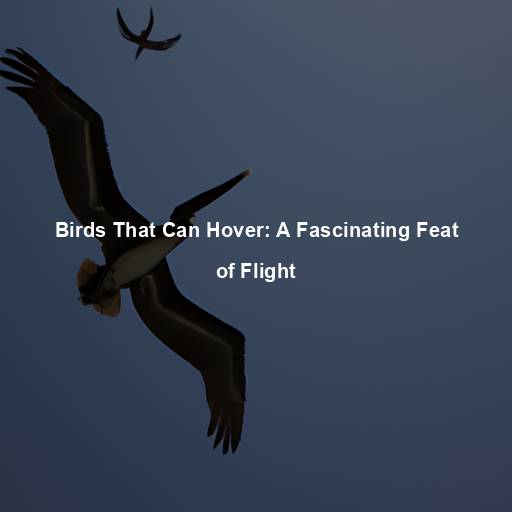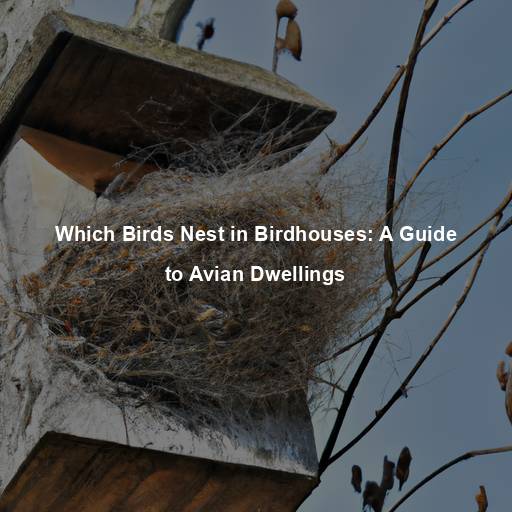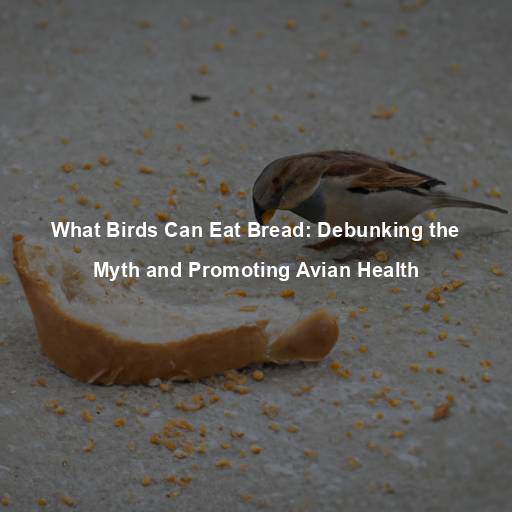Birds That Can Hover: A Fascinating Feat of Flight
Last Updated on November 21, 2023 by Evan
Contents [hide]
- 1 The Marvelous World of Avian Flight
- 2 The Hummingbird: Nature’s Helicopter
- 3 The Kestrel: Master of Aerial Stasis
- 4 The Harrier Hawk: Aerial Mastery in Low Altitude
- 5 The Kingfisher: Diving into Hovering
- 6 The Secrets of Avian Hovering Unveiled
- 7 The Nectar Bat: Nature’s Flying Gardeners
- 8 The Challenges of Hovering
- 9 The Fascination of Hovering Birds
- 10 FAQs – What Birds Can Hover
The Marvelous World of Avian Flight
Birds have captivated humanity for centuries with their ability to take to the skies. Their graceful movements, vibrant plumage, and melodic songs have inspired countless poets, artists, and dreamers. But perhaps one of the most awe-inspiring capabilities possessed by certain avian species is the ability to hover in mid-air. This extraordinary feat of flight is a testament to the remarkable adaptations and evolutionary wonders of our feathered friends.
Evolutionary Adaptations for Hovering
Birds have always intrigued humans with their ability to hover effortlessly in the air. To achieve this mesmerizing feat, these feathered creatures possess baffling adaptations that grant them the power to defy gravity and maintain stability while in mid-air. Join us as we delve into the enchanting world of avian species that have truly mastered the art of hovering, unveiling the extraordinary secrets behind their effortless flight.
The Hummingbird: Nature’s Helicopter
Awe-Inspiring Aerodynamics
In the realm of avian marvels, there exists a species that captivates the senses with an awe-inspiring display of grace and agility – the enchanting hummingbird. These pint-sized wonders, adorned in a vibrant palette of iridescence, possess an uncanny ability to defy the laws of physics and baffle even the most astute observer. Through a symphony of wing beats that mesmerize the eye, they dance amidst the air currents, showcasing an ethereal equilibrium that leaves one breathless. With their intricate figure-eight flight pattern, these avian virtuosos create a harmonious blend of lift and stillness, defying the very essence of our understanding and unraveling the enigma of hovering.
Specialized Muscles and Metabolism
Hummingbirds, those mesmerizing creatures of the avian world, defy the limits of nature with their bewildering wing power and insatiable appetite for nectar. The secret to their ceaseless flight lies in their extraordinary pectoral muscles, which constitute a notable chunk of their overall body mass. But let’s not forget about their prodigious metabolism, working in overdrive to metabolize the copious amounts of nectar required for their energy-intensive escapades. In a true display of nature’s marvels, these tiny aviators embody the essence of perpetual motion and leave us in awe of their unrelenting burst of energy.
Feeding on the Wing
Hovering isn’t just a means of transportation for hummingbirds; it serves a vital purpose in their quest for sustenance. With their long, slender beaks and extendable tongues, they are uniquely adapted to feed on nectar-rich flowers while hovering in front of them. This remarkable feeding strategy, known as nectarivory, allows them to access the sweet nectar hidden within the flowers’ depths.
The Kestrel: Master of Aerial Stasis
A Hunter’s Hover
It’s truly fascinating how nature never fails to amaze us with its diverse strategies for survival. Take the kestrel, for instance – a small falcon that has found an extraordinary way to enhance its hunting prowess. Unlike other birds, which rely on flight to snatch their prey, the kestrel has honed the art of hovering in mid-air, patiently observing the world beneath. This unique behavior showcases the kestrel’s unparalleled adaptability and highlights just how captivating the animal kingdom can be.
Precision in Flight
Witness the awe-inspiring mastery of flight displayed by the exquisite kestrel. With an uncanny ability to defy the whims of the wind, this majestic creature harnesses the power of delicate wing and tail movements to hold its position with uncanny precision. Through this remarkable maneuverability, the kestrel seamlessly surveys its surroundings, poised to unleash its lightning-fast strike upon any unsuspecting prey that catches its keen gaze. Prepare to be captivated by the mesmerizing ballet of power, control, and unwavering focus that the kestrel graces upon the world.
The Hovering Advantage
The kestrel, with its impressive hovering ability, gains a notable upper hand in the relentless pursuit of its prey. Through this unique strategy of remaining motionless, the kestrel cleverly maximizes its energy reserves without compromising its ever-watchful gaze for various critters hidden amidst the dense foliage. And when opportunity strikes, the kestrel effortlessly shifts from a state of eerie stillness to a rapid chase, tapping into its unparalleled aerial prowess to ensure a satisfying feast. This extraordinary balancing act of stillness and swift agility truly sets the kestrel apart in the perplexing world of predator-prey dynamics.
The Harrier Hawk: Aerial Mastery in Low Altitude
Low-Flying Marvels
When it comes to hawks, the harrier hawk takes flight in a league of its own. Unlike its high-soaring counterparts, this bird of prey has perfected the art of low-altitude maneuvers. With its unique hovering prowess, reminiscent of the kestrel, the harrier hawk navigates with utmost grace through challenging terrains like marshlands and reed beds. Prepare to be captivated by the extraordinary skills of this enigmatic predator.
Adaptations for Low-Level Hunting
With their broad wings and long tail, harrier hawks can maneuver with finesse in densely vegetated areas. Their wings are uniquely shaped, allowing them to generate lift even at low speeds. This adaptation enables them to hover effortlessly while scanning the ground for small mammals, amphibians, and even insects.
The Silent Approach
In addition to their hovering abilities, harrier hawks are also known for their stealthy hunting techniques. Their facial disk, similar to that of an owl, helps to funnel sound towards their ears, allowing them to detect the faintest rustle of prey in the undergrowth. This, combined with their low-flying prowess, gives them a significant advantage when it comes to surprising their unsuspecting quarry.
The Kingfisher: Diving into Hovering
Aerial Acrobatics
Few birds can rival the kingfisher’s mesmerizing presence in the wild. With its resplendent feathers that dazzle in the sunlight, this avian marvel captivates onlookers effortlessly. As if its ornate appearance wasn’t enough, the kingfisher possesses a secret weapon in its arsenal – a breathtaking fishing technique known as “aerial kiting”. This elusive act involves a brief moment of hesitation in the air, defying gravity, before the kingfisher plunges into the depths with unrivaled grace and accuracy, claiming its aquatic conquest.
Patience and Precision
Every majestic swoop, every awe-inspiring dive, the kingfisher captures our imagination with its extraordinary aerial feats. Guided by its extraordinary vision, this magnificent bird spots its prey lurking beneath the shimmering surface. Hovering momentarily, its wings fluttering in perfect harmony, it prepares for the imminent plunge into the unknown. With a graceful folding of its wings, it pierces the water with unwavering accuracy, emerging victorious, holding its precious reward in a triumphant grasp.
Adaptations for Aquatic Life
The kingfisher’s streamlined body, long bill, and sharp talons are all adaptations that aid in its underwater hunting prowess. Its wings are short and rounded, reducing drag during flight, while its beak is long and slender, perfectly suited for snatching fish from the water. These adaptations, combined with its hovering abilities, make the kingfisher a true marvel of avian engineering.
The Secrets of Avian Hovering Unveiled
The ability of certain bird species to hover in mid-air is a testament to the incredible diversity and adaptability of nature. From the tiny hummingbird to the majestic kestrel, each bird has evolved unique strategies to harness the power of flight and defy gravity.
Hovering allows these avian wonders to access food sources, hunt with precision, and navigate challenging environments. Their specialized adaptations, from wings that beat at astonishing rates to streamlined bodies and acute senses, enable them to achieve this extraordinary feat.
As our exploration of the enchanting realm of avian creatures persists, let us take a moment to bask in awe and contemplation of their unparalleled talent for hovering, captivating us with their ethereal presence. Whether we chance upon the mesmerizing sight of a hummingbird delicately suspended in mid-air or bear witness to a kestrel’s elegant stillness, it is imperative that we acknowledge the grandeur of flight flaunted by these enchanting beings. Amidst our insatiable thirst for discovery, let us cast our gaze upon the woodpecker, those aerial drummers that bewilder and intrigue us with their distinctive ways.
Drumming in the Air
While woodpeckers are renowned for their ability to peck into tree trunks with remarkable speed and precision, they also possess an intriguing hovering behavior. Woodpeckers use this aerial prowess to drum on objects, such as hollow trees or metal surfaces, to communicate with other woodpeckers and establish their territory.
Aerial Communication
To execute their mid-air drumming, woodpeckers use their sturdy tail feathers as a brace, allowing them to maintain balance and stability while in flight. By hovering in front of their chosen “drumming surface,” they can deliver rapid, rhythmic pecks, creating a distinctive sound that carries through the air. This unique behavior not only serves as a form of communication but also acts as a display of strength and prowess to attract potential mates.
The Nectar Bat: Nature’s Flying Gardeners
Wings of the Night
When we talk about hovering, our minds often drift towards birds, but hold on tight because there’s a twist in this tale. Enter the nectar bat, a mesmerizing creature that challenges the very definition of flight. With tongues that would make even the most ambitious giraffe jealous and muzzles specially designed for this bewildering act, these bats soar into the realm of avian hovering as they delicately sip on floral nectar. Prepare to be captivated by this extraordinary parallel between bats and hummingbirds as they defy expectations and leave us with a lingering sense of wonder.
Aerial Pollinators
In the mystical dance of nature, an unlikely hero emerges – the nectar bat. With delicate finesse, these winged marvels flit from flower to flower, drawn by an irresistible temptation. Little do they know, their very existence intersects with the fundamental cycle of life. As their tiny tongues delve deep into the heart of blossoms, nature’s sweet reward bestows upon them a cloak of pollen, unknowingly transforming them into instrument of flora’s destiny.
Nocturnal Hovering
Unlike hummingbirds, which primarily hover during the day, nectar bats are primarily nocturnal creatures. Their ability to hover in low light conditions showcases their incredible echolocation skills, allowing them to navigate and locate food sources in the darkness of night.
The Challenges of Hovering
The art of hovering is a demanding endeavor, demanding unrivaled vigor, nimbleness, and unique anatomical developments. Only a handful of avian wonders have truly conquered this audacious feat, as it is not without its fair share of trials and tribulations.
Energy Expenditure
The fascinating world of bird flight is a true marvel, filled with bursts of energy and perpetual balancing acts. Hovering, a skill reserved for the most agile aviators, demands a staggering amount of wing-beating and ceaseless adjustments to maintain equilibrium in mid-air. To fuel their incredible aerial journeys, these airborne experts have evolved to feast on nature’s sweetest elixir: nectar. Hummingbirds and nectar bats, among the elite hoverers, tap into this concentrated source of energy, ensuring they have the stamina to keep up with their high-flying lifestyle.
Wing Wear and Tear
Hovering, a seemingly effortless act for birds, involves a complex and intricate dance of wing movements. However, this graceful display comes with a cost – wear and tear on their wings, feathers, and muscles. In order to keep up with the demands of hovering, birds have evolved remarkable adaptations, such as sturdy wing structures, specialized feathers, and muscular strength. Furthermore, birds diligently engage in preening rituals to ensure the impeccable health and functionality of their feathers.
Environmental Factors
When it comes to defying gravity and staying in the air, birds that hover face a host of perplexing challenges brought about by their surroundings. Take wind, for instance. It’s like a mischievous troublemaker, making it extra difficult for these birds to keep a steady position. But fear not, our avian friends have some tricks up their feathers!
The Fascination of Hovering Birds
Witnessing the mesmerizing spectacle of birds defying gravity and hovering in mid-air never fails to astound us, offering a glimpse into the incredible versatility and ingenuity of the natural world. Be it the graceful oscillations of the hummingbird’s wings, the impeccable stability of the kestrel in suspended animation, or the rhythmic percussion of the woodpecker, each avian marvel showcases its distinct methodology in mastering the enigmatic act of hovering. It’s a perplexing symphony of motion, a burst of birdly brilliance that continues to captivate our bewildered minds.
Witness the awe-inspiring spectacle of these magnificent creatures as they exhibit their extraordinary abilities. Marvel at their specialized adaptations, from their powerful muscles and efficient metabolisms to their streamlined bodies and acute senses. Explore how these incredible birds harness the power of hover to access food sources, establish territories, communicate with one another, and conquer even the most daunting of environments. Prepare to be captivated by the burst of life and perplexing wonders that these avian marvels bring to the world.
As our exploration of the avian realm deepens, we are beckoned to immerse ourselves in the intricate realms of birds and their mesmerizing habits. The ethereal phenomenon of avian flight and levitation stands as a testament to the infinite grandeur and intricate intricacies of the universe. Allow your senses to be captivated by the sheer poetry of a bird suspended mid-air, inviting you to embrace the enigmatic world of gravity-defying aerial ballet and the astounding attributes that empower these beings.
FAQs – What Birds Can Hover
What does it mean for a bird to hover?
Have you ever been captivated by the mesmerizing sight of a bird defying gravity, seemingly suspended in mid-air? This remarkable ability, known as hovering, sets certain avian species apart from the rest. While many birds rely on the rhythmic motion of their wings to propel themselves through the sky, these rare creatures possess an astonishing skill to effortlessly remain stationary, defying the laws of nature. It is this perplexing phenomenon that continues to fascinate and bewilder us, as we marvel at the intricate mechanics behind their motionless grace.
Which birds are known to hover?
Several bird species have the remarkable ability to hover. The most famous example is the hummingbird, which is renowned for its hovering capabilities. Other birds that can hover include certain species of kingfishers, kestrels, falcons, and bee-eaters. Additionally, some birds in the nighthawk family, such as the Common Nighthawk, are also adept at hovering.
How do hovering birds achieve levitation?
Have you ever wondered about the sheer wonder of birds effortlessly defying gravity, their wings beating with such a burst of energy? It’s a true marvel of nature! These mystical creatures have unlocked the secret to levitation through an intricate dance of rapid wingbeats and uniquely shaped wings. These wings, often shorter and more rounded than their avian counterparts, grant them unmatched maneuverability and an uncanny ability to maintain their position in the air with bewildering precision. It’s not just their wings, though – their robust pectoral muscles are the unsung heroes behind their hovering prowess, propelling them into a realm of flight that leaves us mere mortals in awe.
Why do birds hover?
It’s truly mesmerizing to witness the enigmatic dance of birds defying gravity as they hover effortlessly in the air. These winged marvels possess an array of motivations for this peculiar behavior, each species with its unique purpose. Take the hummingbird, for instance, whose delicate frame hovers delicately above vibrant blossoms, its slender beak and intricate tongue penetrating the floral depths, indulging in the sweet nectar it craves. Meanwhile, the kestrel and falcon, masters of precision and strategy, employ their hovering prowess as a hunting tactic, silently surveying the world below, waiting for the perfect moment to swiftly dive, seizing their unsuspecting prey. These diverse explanations only deepen the intrigue surrounding the enchanting art of bird hovering, leaving us in awe of nature’s infinite wonders.
Are there any other animals that can hover like birds?
While birds may be the first animals that come to mind when we think of hovering, there are actually a handful of other intriguing creatures endowed with this unique ability. Believe it or not, certain species of bees, wasps, and dragonflies showcase their hovering prowess in the realm of flying insects. And let’s not forget the amazing man-made marvels, like helicopters and hovercrafts, which ingeniously mimic the bird’s levitation techniques through their own mechanical mechanisms. So, whether it’s the delicate dance of an insect or the advanced engineering of a flying machine, the world of hovering is a captivating realm filled with endless surprises.
How can birds hover for such extended periods without getting tired?
In the vast realm of avian prowess, hovering stands as an unparalleled testament to the sheer vitality of our feathered friends. Such a ethereal and captivating feat, however, comes at a hefty cost. These birds, in their valiant pursuit of uninterrupted levitation, have evolved metabolic machinations that defy comprehension. Their diets, laden with a calorific bounty, serve as the lifeblood that sustains the relentless beating of their wings, while their hearts and respiration systems, grand in proportion and efficiency, propel them to new heights. Remarkably, these avian acrobats possess the incomparable gift of torpor, a mysterious state of hibernation-like rest that allows them to hoard their precious energy reserves. A perplexing dance of biology and physics, the secrets behind hovering reveal nature’s boundless complexity.







